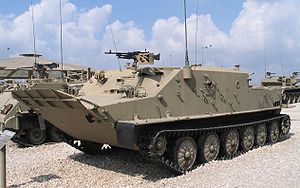BTR-50
| BTR-50 | |
|---|---|

Israeli-modified ex-Syrian or ex-Egyptian late-production model BTR-50PK APC at the Yad La-Shiryon Museum, Israel. 2005.
|
|
| Type | Amphibious Tracked Armored Personnel Carrier |
| Place of origin | Soviet Union |
| Service history | |
| In service | 1954 – late 1970s (USSR) |
| Used by | See Operators. |
| Wars | Six-Day War, Vietnam War, War of Attrition, Lebanese Civil War, Iran–Iraq War, Syrian Civil War |
| Production history | |
| Designed | 1952 |
| Produced | 1954 – 1970 |
| Variants | See Variants |
| Specifications | |
| Weight | 14.5 tonnes |
| Length | 7.08 m |
| Width | 3.14 m |
| Height | 2.03 m |
| Crew | 2 (driver and commander) (+20 passengers) |
|
|
|
| Armor | Homogeneous, cold rolled, welded steel 13 mm front 10 mm sides 10 mm top 7 mm rear |
|
Main
armament |
None or 7.62 mm SGMB medium machine gun (BTR-50P) (1,250 rounds) 14.5 mm KPV heavy machine gun (BTR-50PA) 7.62 mm SGMB medium machine gun (BTR-50PK) (1,250 rounds) |
|
Secondary
armament |
none |
| Engine | V-6 6-cylinder 4-stroke in line water-cooled diesel 240 hp (179 kW) at 1,800 rpm |
| Power/weight | 16.6 hp/t |
| Suspension | torsion bar |
| Ground clearance | 370 mm |
| Fuel capacity | 400 l |
|
Operational
range |
400 km |
| Speed | 44 km/h (road) 11 km/h (water) |
The BTR-50 (BTR stands for Bronetransporter (БТР, Бронетранспортер), literally "armored transporter") is a Soviet amphibious armored personnel carrier (APC) based on the PT-76 light tank. The BTR-50 is tracked, unlike most in the BTR series, which are wheeled. The BTR-50 shares many similarities with two other APCs, the OT-62 TOPAS and the Type 77. While the OT-62 is an improved copy of the BTR-50 developed jointly by Czechoslovakia and Poland, the Type 77, based on the Type 63 amphibious light tank developed by the People's Republic of China (PRC), is not a copy of the BTR-50.
Like the PT-76, the BTR-50 has a flat, boat-shaped hull. Unlike the PT-76, it has a new superstructure added to the front of the vehicle. The hull of the BTR-50 is made of all-welded steel with the crew compartment in the front, the troop compartment in the center and the engine compartment at the rear. It has the ability to transport up to 20 fully equipped infantrymen, who sit on benches that run across the full width of the troop compartment. They mount and dismount the APC by climbing over the sides of the hull. The driver sits in the center of the front of the hull and has three vision blocks and periscopes located at the top of the sloping glacis plate. During night operations, the center periscope can be swapped for the TVN-28 night vision device, which gives the driver clear vision up to 60 meters. The driver also has a small hatch that opens upwards—while it cannot be used to leave the vehicle, it can be opened in relatively safe areas for extra vision. In combat, the hatch is closed and the driver can use a vision block. There is an emergency hatch under the driver's seat. The commander, who sits on the left side of the vehicle at the front, has three vision blocks and periscopes in a projecting bay. On top of this bay is a cupola that opens forward and can be locked vertically; it has a vision block facing forward. The vehicle can operate in temperatures from −40 °C to +40 °C.
The torsion bar suspension consists of six evenly spaced large rubber-tired road wheels with a drive sprocket at the rear and an idler at the front. The road wheels are hollow to assist its amphibious capabilities. These wheels increase the APC's buoyancy by 30%. There are no track-return rollers. The first and last road wheels have a hydraulic shock absorber, the steel tracks have a single pin and 96 links each when new. There is a small, thin, horizontal skirt over each track. The BTR-50 is powered by a V-6 6-cylinder 4-stroke in line water-cooled diesel engine developing 240 hp (179 kW) at 1800 rpm. This gives it a road speed of 44 km/h with a cruising range of 400 km. The vehicle can negoiate 30° side slopes, ascend 60° gradients, cross 1.1 m high vertical obstacles and 2.8 m wide trenches. The engine has a cooling system and a pre-heater (intended for ignition when the air temperature is −20 °C or below). The APC has a five gear manual shaft-type transmission system similar to that in the T-34/85 medium tank. The gearbox has four forward and one reverse gear. The vehicle has a side clutch that enables it to make turns, mechanical transmission and a bandbrake. The vehicle has three fuel tanks, two on the right at the front of the engine compartment and one at the rear. The total fuel capacity is 400 liters. The vehicle has four mounts for additional external fuel tanks located on the rear of the hull; the two on the hull corners are for a flat external tanks, whereas the two in the center are for a drum-type of tank.
...
Wikipedia
